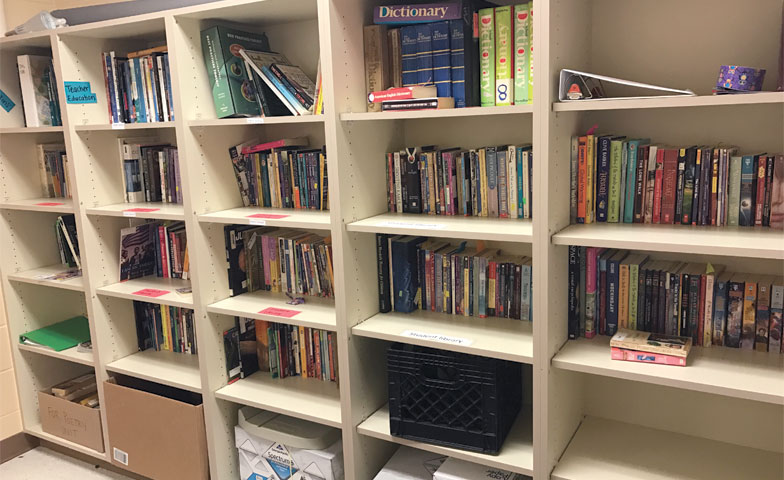Improve learning and show students you value them by rethinking the physical space of the classroom
I hail from room 604, where the sign on the door reads “resource room.” However, I actually teach sixth grade English language arts class at full capacity in this room, which was designed for small group support classes. Sometimes I feel like I am teaching an aerobics class in a shoebox, and some days it smells that way, too. What bothers me most is the frustration that has come from having to teach in a way that conflicts with my philosophy of education. I do not see myself as queen of a domain, but rather as a “guide on the side” encouraging student learning.
To create a student-centered classroom, I altered the physical setting: the geography of the classroom. Taking inspiration from Nancy Atwell’s In the Middle, I re-organized my space for a writer or reader workshop. Room 604 has two “perks” I took advantage of: a long counter across the back of the room with good cabinetry built above and a substantial sized storage closet behind the whiteboard.
Creating Space for Student Use
The first task was to reorder the horizontal spaces in the room. There was a large table used for laying out papers and a good sized teacher desk on which my materials were scattered. Effectively used? No. I made these spaces available to students by clearing “my” teacher desk and eliminating many boxes filled with “someday” items that I believed I would use, but never did. Eliminating them was a no-brainer.
I could not change the size and shape of the room, or the number of student desks required, but I could “create” space by eliminating the teacher desk and two unused file cabinets and clearing a table. I now use a two-foot space of the counter for my workspace with laptop and incoming daily papers. The bulk of my curriculum materials, office paperwork, department resources, parent contact, and lesson planning are now organized in labeled binders in the overhead cabinets. The remainder of the cleared counter has become the student supply center where students have access to certain supplies they can use, borrow, or take without needing to ask permission. They begin to self-help, which I love, for it helps develop their sense of responsibility and maintains my sanity. The rest of the space along the counter has become workspace for students to work in small groups or individually.
I rotated the teacher desk and put it against the other table creating what looks like a fairly long dining room table where three or four editing partners can meet to collaborate on a writing project. Students love moving to this area. Rather than spread materials needed horizontally, I used wall space to hold folders with materials needed by students as they edit written work.
Creating a Library
The last area I repurposed was the closet, which has become a mini library. I discussed this conversion with my administrator beforehand. He supported the plan with these two rules to be in place: the light stays on and the door is always open. This 100 square foot area now houses a surprisingly large collection of age appropriate books, a table, and a standing height desk. A few students can work comfortably in the library reading, writing, or doing independent projects. The built-in shelves hold more than 300 books, ones I had accumulated over the years. The library is student-run as well. Volunteer “librarians” sort books and place them on the correct shelf, follow up with books loaned out, and maintain the logs. The librarians rotate regularly so more students can share this responsibility.
Making these changes also helped me link the geography of a classroom with body language. When I used the teacher desk, it was a geographic and physical barrier between my students and myself. I prefer that my posture expresses to them that they matter most. In 50 minutes moving among them, they sense that they are my top priority. This was worth the sacrifice of a desk and some creature comfort. By sharing with the students what I was doing and why as changes were being made, their buy-in was certain and appreciated. I believe that far too many teachers severely underestimate the young adolescent capacity to understand a greater purpose. They are already curious and asking “why,” so why not show them how the clock ticks rather than just the face of the clock.
Summary
Re-imagining my classroom has led to these important results:
- Students are valued and thrive in a student-centered classroom
- My identity as a teacher has evolved from being a taskmaster to being a guide
- Seldom used horizontal surfaces became valuable, functional spaces
- Student independence and collaboration have both been nurtured
- The “geography” of my classroom now expresses my fundamental belief about the importance of students as individuals
This re-imagination of the classroom has greatly benefitted the total learning environment, with students’ learning increasing.
How might you alter the geography of your classroom? While you may not have a closet, are there spaces that are underutilized? Can the space of the teacher desk be deemed for student use?
Consider taking steps to improve the learning environment of your classroom. The students will appreciate it, and certainly they are worth it.
